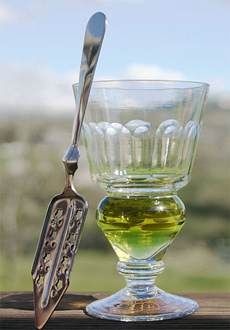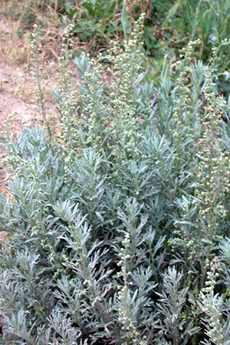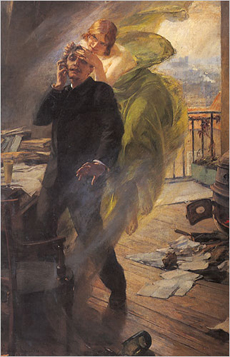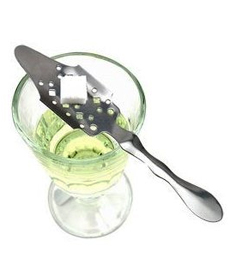 Absinthe in a glass, alongside the slotted sugar spoon used to add sugar water. Photo by Eric Litton | Wikimedia. Absinthe in a glass, alongside the slotted sugar spoon used to add sugar water. Photo by Eric Litton | Wikimedia.
|
KAREN HOCHMAN is editorial director of THE NIBBLE.
|
|
March 2011
Last Updated March 2013
|
 |
Product Reviews / Main Nibbles / Cocktails & Spirits
Absinthe
An Overview Of The Controversial “Green Fairy”
Absinthe Introduction
March 5th is National Absinthe Day, celebrating a green-colored spirit made from the flowers and leaves of the wormwood herb (Artemisia absinthium). The distillation includes fennel seed and green anise, which gives the drink an anise flavor.
Absinthe is not a liqueur, which would indicate the addition of sugar to the distillation.
It is perhaps the spirit with the most controversial past. Claims are that it made Parisian writers and artists of the 19th century, hallucinate and go mad. It was banned in America—and in France, as well—for scientific reasons recently discovered to be incorrect.
Nineteenth-century scientific studies blamed a potentially toxic chemical component of wormwood, thujone, for the hallucinations and madness. However, recent studies show this to be erroneous thinking.
While thujone can be dangerous in large quantities, there is far too little of it in absinthe to have any negative effect. General alcoholism, possibly in combination with other medical maladies, were the most likely causes of hallucinations and madness.
Although absinthe was denounced at the highest levels, there is no proof that it is any more dangerous than any other spirit. Any extra psychoactive properties have been greatly exaggerated.
From 1915 through 2007, it wasn’t legal to import absinthe into the U.S. As you’ll read shortly, new testing on the properties of thujone made it clear that the chemical was not responsible for the ills attributed to it.
|
|

With all its bad press, wormwood is an attractive shrub, with silvery green leaves and tiny yellow button-like flowers. Photo courtesy Weeds.Hotmeal.net. |
The History Of Absinthe
Long before it was distilled into absinthe, wormwood was used in ancient Egypt and Rome for stomach and liver maladies, as an antiseptic and to counteract hemlock and poisonous mushrooms.
The distillation into the spirit absinthe was done by Dr. Pierre Ordinaire, a French doctor residing in Couvet, Switzerland, around 1792. As with many spirits, its original purpose was medicinal.
In the 1840s, absinthe was given as a malaria treatment to French troops serving in tropical climates. The troops returned home with a taste for it, and absinthe was on its way to claiming its place in history.
The spirit became popular in the artists-and-writers community of Paris. Charles Baudelaire, Amedeo Modigliani, Arthur Rimbaud, Henri de Toulouse-Lautrec, Vincent van Gogh, Paul Verlaine and Oscar Wilde were fans. Artistic types claimed that "la fée verte" (French for “the green fairy”), as absinthe was often called, helped spur their creativity. Read more about “her” here.
But the spirit—and its perceived large quantity of thujone—was denounced by politicians and other leaders as a dangerous, addictive, psychoactive drug. By 1915, absinthe had been banned in the United States and in most European countries.
|
|

“Green Muse,” a painting by Albert Maignan (1895) depicts a Parisian poet succumbing to the lure of the green fairy. |
And so it went for more than 90 years, with an occasional bottle smuggled into the country.
In the early 21st century, research conducted on pre-prohibition bottles of absinthe showed the thujone levels to be a fraction of what was original thought—too small an amount to have any negative effect. In 2007, the first American absinthe, Lucid, was distilled distributed in the U.S.
No laws were changed or broken:
- There is no law that prohibits use of the name, absinthe.
- The law prohibits the sale and/or consumption of any drink that contains an excess of 10ppm of thujone.
- Using modern analysis on old bottles, a number of pre-1915 absinthe brands would have been legal in the U.S.—including the iconic absinthe brand, Pernod Fils.
How Strong Is Absinthe & How To
Drink It
Absinthe, typically distilled at 124 proof, is diluted with water before drinking—except by the hardy few who can handle 124 proof (most bourbon, gin, scotch, tequila, vodka, etc. is 80 proof).
The water for diluting the absinthe
is often poured over a sugar cube. The photo shows an absinthe spoon: a flat surface to hold the sugar cube. Slits in the spoon allow the water to drip through, carrying some sweetness from the sugar.
Try it to see if you agree with Modigliani, Toulouse-Lautrec, van Gogh, Oscar Wilde and their friends.
|
|

Diluting absinthe with sugar water: the water drips over the sugar cube. Get your own absinthe glass and spoon. |
© Copyright 2005-
Lifestyle Direct, Inc. All rights reserved. Images are the copyright of their respective owners.

|







